20 Games to Develop Gross Motor Skills and Get Active
Exercise is really important for everyone, boosting our health and happiness and overall wellbeing. It can also be lots of fun!
Unfortunately, if our children struggle with higher-level gross motor skills or have coordination difficulties they may avoid participating in exercise and sport. Physical limitations – such as a weak core, or shoulder and pelvic instability – makes activity more difficult for them, which can be dispiriting.
To make movement more appealing for our children, we need find ways to make it enjoyable and achievable. We also need to build exercise into our daily schedule, so it becomes an integral part of our child’s day-to-day life. This will help them develop strength, stamina, stability, mobility and gross motor skills, which will serve them well as they grow.
Below we share a number of great active games we can enjoy with our child at home. Because the focus is on fun, rather than achievement, these games are accessible for even the most reluctant children.
Some of these games will work well with several children present (great if siblings want to get involved!). However, many can be played one on one with our child, or just with our child playing alone.

20 fun activities for the home
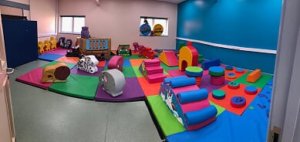 Obstacle course options are endless. You want to set it up to get your child to move in as many different ways as possible. Use furniture to make your course – setting it up with the help of your child is a lovely way to get them active as they will need to carry and move furniture and objects with you.
Obstacle course options are endless. You want to set it up to get your child to move in as many different ways as possible. Use furniture to make your course – setting it up with the help of your child is a lovely way to get them active as they will need to carry and move furniture and objects with you.Let them come up with new obstacles as it will work their imaginations. You could have themes on different days- e.g. Pirates, Beach, Jungle, Castles. You can get some ideas from our video.
Once your obstacle course is set up, you can also add some extra stages and mark them with a piece of paper or some tape. For example:
Throw and catch a ball
Jump on the spot
Stand on one foot
Once you have set this up you can ask them to negotiate the obstacles in different ways e.g. Backwards, crawling or whilst blindfolded with someone giving instructions of how to get through the course.
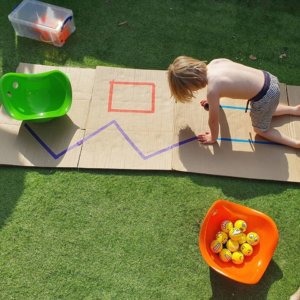 An obstacle path is a great way to get a mix or movement and activities into everyday life.
An obstacle path is a great way to get a mix or movement and activities into everyday life.You can draw out an obstacle course with painters tape in a room or along your walls. This great video can give you some ideas of how to set up a tape obstacle course/ sensory path.
Maybe put this along your corridor and your whole family can follow the steps each time they go through the corridor.
You can also do this along the pavement using chalk. See our video for ideas of what to do.
Maybe put this along your corridor and your whole family can follow the steps each time they go through the corridor.
You can also do this along the pavement using chalk. See our video for ideas of what to do.
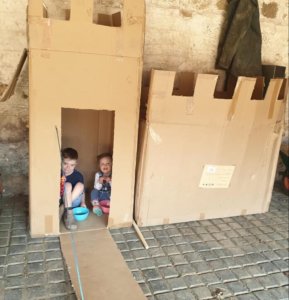 This has the added bonus of creating a space for them to play in after it is built.
This has the added bonus of creating a space for them to play in after it is built.Provide your child with sheets and they can build a den anywhere in the house. The process of building it should mean lots of moving furniture and lifting cushions so is a great way to get them moving and improving their strength without realising it.
Wheelbarrow walking is incredibly challenging but brilliant for our children. Not only does it strengthen the shoulders and arms but it is also brilliant for the core which is often weak with children with developmental delay. As it is so challenging, try to give more support rather than moving down this sequence too quickly as they may give up too quickly if it is far too hard for them.
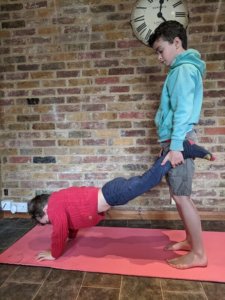 Hold your child by their hips with their legs straddling you and their hands on the floor. Move around the floor picking up objects for as far as you can go.
Hold your child by their hips with their legs straddling you and their hands on the floor. Move around the floor picking up objects for as far as you can go. Move your hands down to your child’s knees and walk around the room – picking up objects or playing a matching game or skittles.
If you can, hold your child by their ankles. Make sure they keep their bottom in the air and don’t hang their tummy’s down. Again find a game to make this more entertaining.
As your child gets stronger you could try to get from one end of the house to another – even trying going up the stairs.
You could also make an obstacle course to go around.
This game needs some concentration but can be a brilliant challenge for our children.
Set up a balance board on a table or on the floor with a board and a bottle or rolling pin.
See this video for an explanation of how to play this great hand balance game.
Painters tape works well for tape games as it doesn’t leave a mark when you remove it and is colourful.
You can use tape to make targets on the wall or floor for our children to throw balls or other objects to score points or goals.
This video gives lots of other ideas of games to play with tape.
Take photos of objects around your home using either a tablet or just on your computer or phone.
Your child then needs to find each object around the house. See this ‘Our Home’ video as an example of the game in action).
You could also hide objects around the house for the child to find.
This is a great copy game. One person does an action and the other person has to copy them.
This is a great way to convince your child to do any action you want from them!
Alternatively ask them to lead the game and see where their imagination takes you.
Play this game on a gym ball, standing on 1 leg or stood on a wobble cushion for extra work for their pelvic stablisers.
This game can provide hours of fun. 1 person can hide around the home while the other counts out loud to 10 and then has to go around the home to find them.
Take turns in hiding and finding.
If your home isn’t very big, you could adapt this to hiding an object for them to find – e.g. a sock or stuffed animal.
You may want to start this game just in one room until they understand the game.
This is fabulous for working shoulder stability muscles.
If you don’t have a parachute at home then a sheet will do the same job.
Hold onto the edges between at least 3 of you.
Put objects in the middle and make the objects move around the sheet by lifting or lowering your arms.
Challenge your children to try and work out how to make the object jump as high in the air as possible or go around in a circle as quickly as possible.
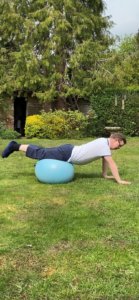 Use a gym ball for a fun way to challenge your child’s balance.
Use a gym ball for a fun way to challenge your child’s balance.When using a gym/physio ball, make sure you have complete control of the ball and your child to try this – it may take 2 adults. You can wedge the ball into the corner of the room to make it more stable until you are more confident in your handling.
Hold your child at their hips so you have control of their bottom and the ball. Very slowly move the ball in all directions.
As they get more confident you can move in bigger movements but keep going very slowly to challenge them.
Hold the position at the extreme of where they can go to make it a little harder but have a second person ready to catch them if they fall.
See if they can balance themselves sat on the ball with feet on the floor. If they manage this, ask them to lift 1 leg to balance.
Ask them to lie back on the ball to pick up an object behind them and then make them sit up to give you the item.
Be careful if your child is impulsive and lacks a sense of danger as gym balls can be a recipe for disaster in the wrong hands!
Jumping is a fabulous workout for children and is often difficult for our children with DCD as it requires power and good knee strength and stability.
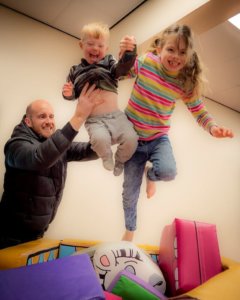 Start on a bouncy surface to show them how. Encourage them to bend their knees between jumps. Your child can jump on the bed, off the sofa onto a pile of cushions (use a fitted sheet to help make sure the cushions won’t slip away as they bounce onto them) or just on the floor.
Start on a bouncy surface to show them how. Encourage them to bend their knees between jumps. Your child can jump on the bed, off the sofa onto a pile of cushions (use a fitted sheet to help make sure the cushions won’t slip away as they bounce onto them) or just on the floor.Try giving them challenges – how many jumps can they do in a row. Can they jump forward or on the spot. Can they tuck their feet up as they jump and then land on their feet etc.
If you have a trampoline then these Trampoline Tutorials take you through the basic trampoline techniques in a very thorough and well described way. Trampolining can be dangerous so we advise nets around the trampoline and supervision.
-
Dancing is a brilliant form of exercise. There are numerous YouTube channels with music to dance along to for younger kids. Older children will probably prefer pop music, or they may have their own favoured genre! Turn up the music and let your child dance however they want to.
-
Our ‘Music at Home’ page shares some ideas of YouTube channels to try. Find one song that your child especially likes. Help your child with the movements to start with and, over time, they may well anticipate the next movement and start to take over. This is a great way to get a daily workout into your child’s life.
-
This video from Flamingo chicks is the first in a series of inclusive dance videos which use Makaton and easy to follow steps to help your child to dance. They are each themed (this one is Space). Look out for more coming soon.
-
These videos from ‘Just Dance Kids’ demonstrate some dance routines for your children to follow along to nursery rhymes and other well known childhood songs.
 They could pretend to be different animals and make a game of it – try being a snake on the floor, a crab on their hands and feet (facing upwards) or bear walk on hands and feet, or kangaroo jumps.
They could pretend to be different animals and make a game of it – try being a snake on the floor, a crab on their hands and feet (facing upwards) or bear walk on hands and feet, or kangaroo jumps.Make an obstacle course and challenge your child to complete it as different animals.
Put names of different animals into a hat and the family has to guess what animal they are.
Sports Day Games
Ask your child to put their feet into a pillow case – getting their feet into the corners helps with this game. They should then stand up and hold onto the top edge of the pillow case.
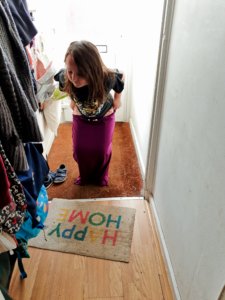
Try walking or jumping around the house. Be careful as this may be slippery on hard floors.
Be warned – pillow cases can rip!
An egg and spoon race is a great way to challenge hand eye coordination while multi-tasking. If your child struggles with keeping the ball on the spoon, try with a soft toy on a wooden spoon.
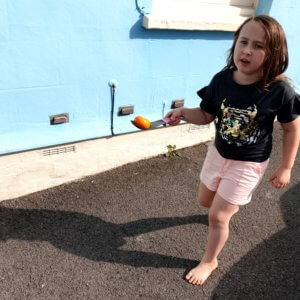
Your child/ren should get from A to B without the ball falling of their spoon.
Progress this by putting obstacles in the way. Firstly just to walk around, then try to step over objects.
Balance an object on their head.
Using a beanbag or soft toy is great.
Try to get from one end of the room to the other without it falling off your head.
Stand 2 children of similar sizes side by side their feet next to each other. If there aren’t 2 children, try this with your child but remember to remove your shoes to reduce the risk of stepping painfully on their feet
Tie a dressing gown cord around the 2 people’s ankles. Make it nice and tight to make this more comfortable. Hold each other close and try to walk.
Set up several balls/ socks or beanbags about 1 meter apart with a bucket/ laundry basket at the end of the line (1m away).
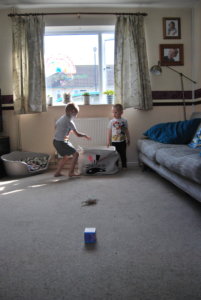
Your child should start at the bucket end and run to pick up the first ball/ beanbag.
They should then run back to put it in the bucket.
Next run to the second ball and run back to put it in the bucket.
They should continue until all the beanbags are in the bucket.
Use a combination of the sports day ideas above (and any others your think of) to make a great relay race around your home, each person taking their turn to complete a challenge.






